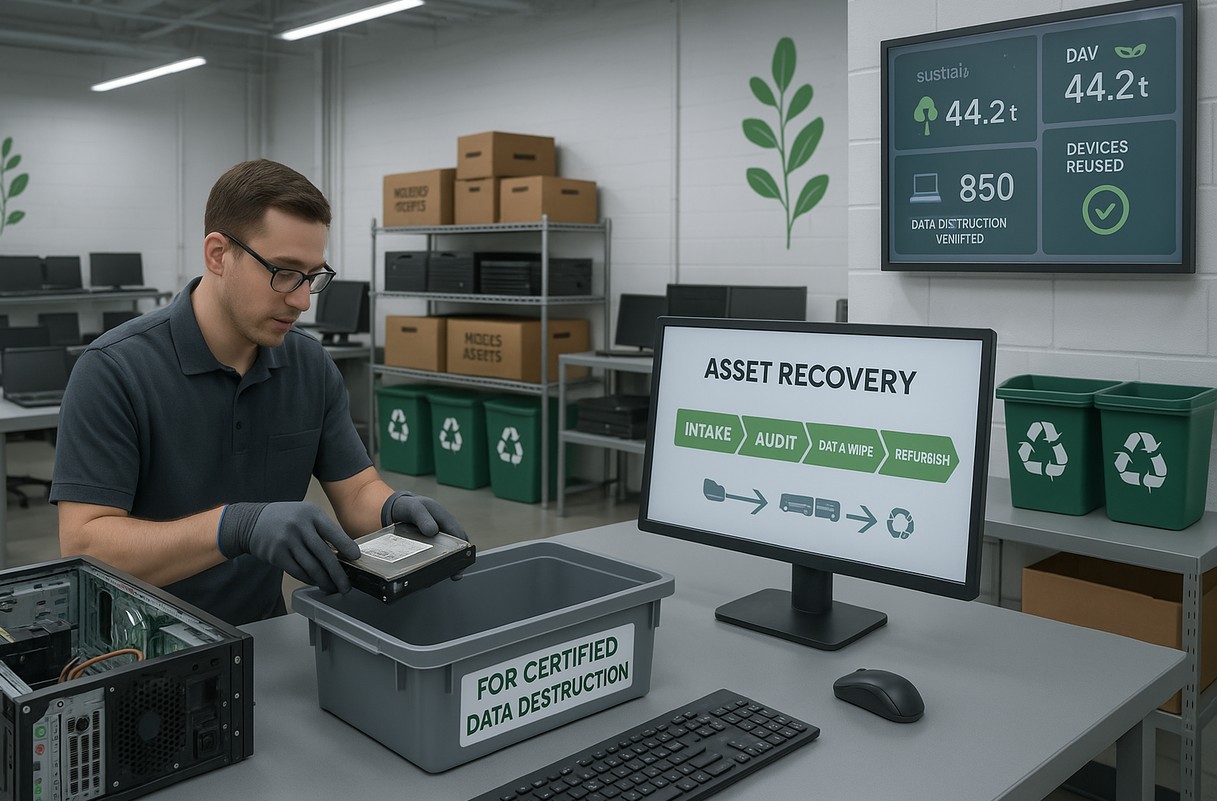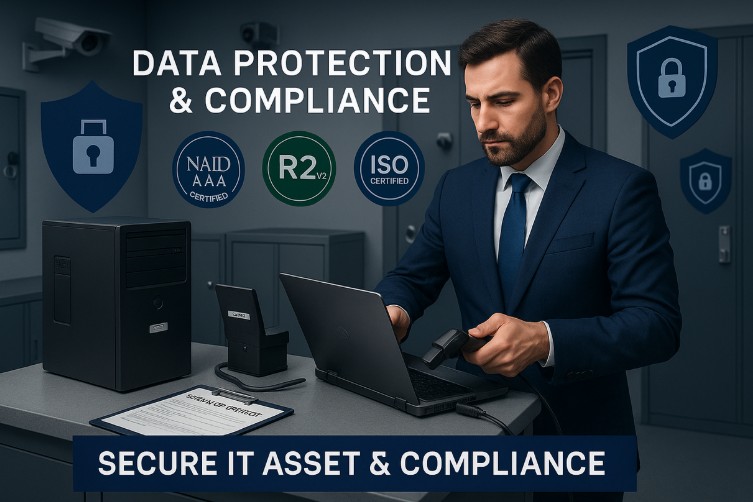In today’s data-driven, security-conscious business environment, IT asset recovery is no longer a back-end consideration, it’s a front-line strategy. From cost savings to environmental impact, the way your company manages decommissioned IT hardware can influence everything from regulatory compliance to your bottom line. With the IT asset disposition (ITAD) market projected to exceed $40.9 billion by 2032, forward-thinking businesses are recognizing IT lifecycle management as a competitive advantage.
Understanding IT Asset Recovery
Definition and Importance
IT asset recovery is the structured process of retrieving, assessing, and then redeploying, reselling, recycling, or securely disposing of outdated, unused, or retired IT hardware assets. This includes everything from servers and desktops to laptops, mobile devices, and network gear.
The stakes are high. Poor asset recovery can result in data breaches, unnecessary expenses, regulatory penalties, and environmental harm. Conversely, a secure, efficient IT asset recovery strategy enhances organizational security, boosts sustainability efforts, and ensures value is recaptured at the end of every asset’s lifecycle.
Key Benefits for Businesses
- Cost Recovery: Resale or reuse of hardware reduces capital expenditures.
- Data Security: Proper erasure and destruction protect sensitive information.
- Sustainability: Reducing e-waste supports environmental, social, and governance (ESG) and compliance goals.
- Compliance: Meets requirements under GDPR, HIPAA, and other regulatory frameworks.
Steps in the IT Asset Recovery Process
1. Initiating Retrieval After Offboarding
The IT asset recovery process often begins with employee offboarding. Immediate retrieval of laptops, phones, access tokens, and other devices ensures accurate asset inventory management and prevents data leakage. Streamlined asset tagging and tracking systems help mitigate losses starting from day one.
2. Secure Data Sanitization and Erasure
Following the National Institute of Standards and Technology (NIST) 800-88 Rev.1 guidelines, secure data sanitization ensures all data is completely removed or rendered unrecoverable. Common practices include:
- Data Wiping (software-based)
- Degaussing (for magnetic storage)
- Physical Destruction (shredding, crushing)
Certification of data erasure, such as a Certificate of Destruction, is critical for audit trails and regulatory compliance.
3. Evaluating Resale or Redeployment Potential
After sanitization, assets are evaluated for reuse, resale, or recycling. Devices less than five years old may still hold market value. In fact, up to 50% of returned electronics are fully functional and can be resold or repurposed, unlocking substantial residual value.
4. Engaging Professional Asset Recovery Services
Certified ITAD providers handle secure transport, data erasure, asset valuation, and reporting. Their services typically include:
- Chain-of-custody documentation
- Environmental compliance support
- Value recovery optimization
- Final asset disposition reports for accounting and ESG tracking
Cost Savings Through Professional IT Asset Recovery Services
Partnering with an experienced IT asset recovery provider can significantly reduce operational costs. One service provider reported boosting recovery rates from minimal returns to over 80-90%, saving organizations hundreds of thousands of dollars in IT budgets.
Moreover, the global ITAD market’s growth trajectory, valued at $18.4 billion in 2023 and expected to surpass $40.9 billion by 2032, highlights how critical this service is becoming. According to Transparency Market Research, the market is also forecasted to reach $34.6 billion by 2031, driven by growing concerns over data security and sustainable disposal.
Data Protection Strategies in IT Asset Recovery
Data breaches can cost companies millions and cause irreparable damage to reputations. Secure IT asset disposal involves:
- Following security compliance standards (e.g., NIST 800-88)
- Maintaining a secure chain of custody
- Ensuring proper destruction of storage devices
- Documenting all data erasure processes
Certified ITAD vendors offer these protections as standard, greatly minimizing data breach risks.
Sustainable IT Asset Recovery Practices for ESG Compliance
Sustainability isn’t a buzzword, it’s an imperative. Responsible asset recovery contributes to the circular economy by:
- Reusing viable components
- Recycling materials like lithium batteries, PCBs (printed circuit boards), and LCD panels
- Reducing e-waste sent to landfills
This approach supports compliance with environmental standards such as ISO 14001 and promotes long-term corporate sustainability goals.
Top IT Asset Recovery Challenges and How to Solve Them
Overcoming Communication Barriers
Lack of coordination between HR, IT, and procurement teams can delay or derail recovery processes. Establishing unified asset management protocols and clear lines of responsibility are key.
Handling Diverse IT Environments
Hybrid environments with on-premise, cloud, and remote assets create complexity. Asset discovery tools and centralized IT asset inventory platforms help standardize oversight.
Mitigating Data Loss Risks
Even one untracked or unrecovered device can lead to significant data exposure. Robust lifecycle tracking and real-time reporting help close these gaps.
How to Maximize Recovery Rates: Expert Tips
- Early Employee Communication: Set clear expectations during onboarding and offboarding.
- Utilize Automated Solutions: Implement automated asset discovery and tagging tools.
- Implement Asset Tagging: Use RFID tags or serial-based identifiers for all assets.
- Track with Software: Adopt a Configuration Management Database (CMDB) solution to maintain oversight.
How to Choose the Best IT Asset Recovery Service Provider
Key Criteria for Evaluating IT Asset Recovery Vendors
- Certifications: Look for R2 and ISO/IEC 14001.
- Security Measures: Evaluate their data destruction methods and documentation protocols.
- Experience: Check their client portfolio and service track record.
- Reporting: Ensure they provide detailed end-of-life documentation.
Essential Questions to Ask Your IT Asset Recovery Providers
- Do you offer a certificate of destruction for each device?
- How do you ensure secure data deletion?
- Can you support global logistics and compliance?
- What systems do you use to track the chain of custody?
Why Certified IT Asset Disposition Vendors Matter
Certified ITAD vendors are equipped to navigate compliance frameworks, mitigate environmental risks, and securely manage the end-of-life phase. Their protocols typically include:
- Verified data wiping aligned with NIST standards
- Comprehensive environmental compliance reporting
- Secure transportation and warehousing procedures
- Certificate of data destruction and recycling documentation
This not only supports audit-readiness but also protects your brand from legal consequences and reputational damage.
Best Practices for Successful IT Asset Management
Build Strategic Partnerships
Work with providers that act as trusted extensions of your internal IT asset management (ITAM) team. Long-term relationships improve operational efficiency, reporting accuracy, and lifecycle consistency.
Certification and Compliance Standards
Adopt globally recognized standards such as:
- NIST 800-88 Rev.1 – Secure data destruction
- ISO/IEC 19770-1:2017 – IT asset management
- R2 – E-waste recycling standard
Aligning with these frameworks ensures data privacy, regulatory compliance, and environmental responsibility.
The Strategic Value of IT Asset Recovery
IT asset recovery is more than an end-of-life checklist—it’s a core strategy for reducing risk, reclaiming value, and supporting long-term sustainability. By working with certified partners and aligning with industry standards, your organization can turn decommissioning into a competitive advantage.
Want to streamline your IT asset recovery process and boost ROI while staying compliant? Contact OEMSource today to learn how we deliver secure, sustainable, and value-optimized solutions tailored to your business.
Frequently Asked Questions
What is IT asset recovery?
IT asset recovery is the process of retrieving, securely erasing, and either redeploying, reselling, or recycling retired IT hardware assets.
Why is certified data erasure important?
Certified erasure demonstrates regulatory compliance with data protection regulations and significantly reduces the risk of data breaches or data leaks.
How can I ensure my provider is secure and compliant?
Look for certifications like R2 and ask for a certificate of destruction with every recovered asset.
What can I do with old devices that aren’t reusable?
Recycle them through a certified ITAD vendor who responsibly processes e-waste and reclaims valuable materials.
What tools can help manage IT asset recovery?
Use ITAM platforms, CMDB systems, and automated discovery tools to improve lifecycle visibility and recovery oversight.





